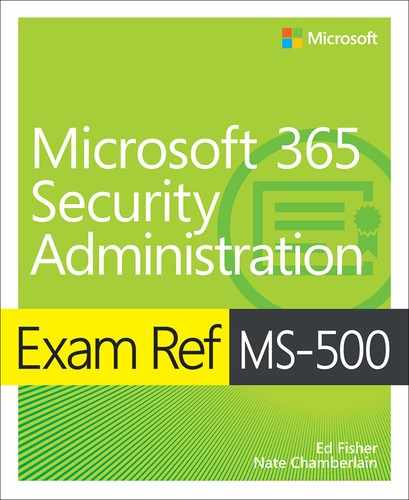Contents
Quick access to online references
Errata, updates, & book support
Chapter 1 Implement and manage identity and access
Skill 1.1: Secure Microsoft 365 hybrid environments
Plan Azure AD authentication options
Plan Azure AD synchronization options
Monitor and troubleshoot Azure AD Connect events
Implement Azure AD group membership
Configure and manage identity governance
Skill 1.3: Implement authentication methods
Implement multifactor authentication (MFA)
Plan and implement device authentication methods like Windows Hello
Configure and manage Azure AD user authentication options
Skill 1.4: Implement conditional access
Plan for compliance and conditional access policies
Configure and manage device compliance for endpoint security
Implement and manage conditional access
Skill 1.5: Implement role-based access control (RBAC)
Skill 1.6: Implement Azure AD Privileged Identity Management (PIM)
Implement and configure Azure PIM roles
Manage Azure PIM role assignments
Skill 1.7: Implement Azure AD Identity Protection
Configure Identity Protection alerts
Review and respond to risk events
Secure Microsoft 365 hybrid environments
Implement authentication methods
Implement role-based access control (RBAC)
Implement Azure AD Privileged Identity Management
Implement Azure AD Identity Protection
Chapter 2 Implement and manage threat protection
Skill 2.1: Implement an enterprise hybrid threat protection solution
Planning an Azure Advanced Threat Protection (ATP) solution
Install and configure Azure ATP
Manage Azure ATP Workspace Health
Integrate Azure ATP with Microsoft Defender ATP
Skill 2.2: Implement device threat protection
Plan and implement a Microsoft Defender ATP solution
Monitoring Microsoft Defender ATP
Skill 2.3: Implement and manage device and application protection
Configure and manage Windows Defender Application Guard
Configure and manage Windows Defender Application Control
Configure and manage Windows Defender Exploit Guard
Configure and manage Windows 10 device encryption
Plan for securing applications data on devices
Define managed apps for mobile application management (MAM)
Protect your enterprise data using Windows Information Protection (WIP)
Configure Intune App Protection Policies for non-Windows devices
Skill 2.4: Implement and manage Office 365 ATP
Configure Office 365 ATP anti-phishing policies
Define users and domains to protect with Office 365 ATP Anti-Phishing
Configure actions against impersonation
Configure Office 365 ATP anti-spam protection
Enable Office 365 ATP Safe Attachments
Configure Office 365 ATP Safe Attachments policies
Configure Office 365 ATP Safe Links policies
Configure Office 365 ATP Safe Links blocked URLs
Configure Office 365 Threat Intelligence
Integrate Office 365 Threat Intelligence with Microsoft Defender ATP
Review threats and malware trends on the Office 365 ATP Threat Management dashboard
Review threats and malware trends with Office 365 ATP Threat Explorer and Threat Tracker
Create and review Office 365 ATP incidents
Review quarantined items in ATP
Monitor online anti-malware solutions using Office 365 ATP reports
Perform tests using Attack Simulator
Skill 2.5: Implement Azure Sentinel for Microsoft 365
Plan and implement Azure Sentinel
Configure Playbooks in Azure Sentinel
Manage and monitor Azure Sentinel
Respond to threats in Azure Sentinel
Protecting users from phishing attacks
Using Office 365 Threat Intelligence
Chapter 3 Implement and manage information protection
Skill 3.1: Secure data access within Office 365
Implement and manage Customer Lockbox
Configure data access in Office 365 collaboration workloads
Configure B2B sharing for external users
Skill 3.2: Manage Azure Information Protection (AIP)
Configure Sensitivity Labels and policies
Integrate AIP with Office 365 Services
Skill 3.3: Manage Data Loss Prevention (DLP)
Create and manage DLP policies
Create and manage sensitive information types
Skill 3.4: Implement and manage Microsoft Cloud App Security
Plan Cloud App Security implementation
Configure Microsoft Cloud App Security
Manage entries in the Cloud app catalog
Manage apps in Cloud App Security
Manage Microsoft Cloud App Security
Configure Cloud App Security connectors and OAuth apps
Configure Cloud App Security policies and templates
Review, interpret, and respond to Cloud App Security alerts, reports, dashboards, and logs
Secure data access within Office 365
Manage Azure Information Protection (AIP)
Manage Data Loss Prevention (DLP)
Implement and manage Microsoft Cloud App Security
Chapter 4 Manage governance and compliance features in Microsoft 365
Skill 4.1: Configure and analyze security reporting
Configure Windows Telemetry options
Configure Office Telemetry options
Review and interpret security reports and dashboards
Plan for custom security reporting with Intelligent Security Graph
Review Office 365 Secure Score actions and recommendations
Configure alert policies in the Office 365 Security and Compliance Center
Skill 4.2: Manage and analyze audit logs and reports
Plan for auditing and reporting
Configure Office 365 auditing and reporting
Review and interpret compliance reports and dashboards
Skill 4.3: Configure Office 365 classification and labeling
Plan for data governance classification and labels
Monitor for leaks of personal data
Create and publish Office 365 labels
Skill 4.4: Manage data governance and retention
Plan for data governance and retention
Review and interpret data governance reports and dashboards
Define data governance event types
Define data governance supervision policies
Import data in the Security and Compliance Center
Skill 4.5: Manage search and investigation
Plan for content search and eDiscovery
Delegate permissions to use search and discovery tools
Use search and investigation tools to perform content searches
Skill 4.6: Manage data privacy regulation compliance
Plan for regulatory compliance in Microsoft 365
Review and interpret GDPR dashboards and reports
Manage Data Subject Requests (DSRs)
Review Compliance Manager reports
Create and perform Compliance Manager assessments and action items
Configure and analyze security reporting
Manage and analyze audit logs and reports
Configure Office 365 classification and labeling
Manage data governance and retention
Manage search and investigation
